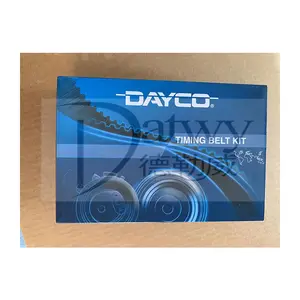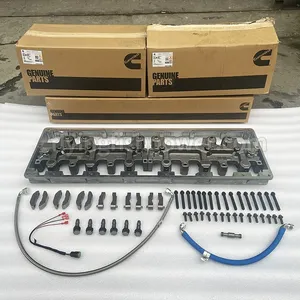(268 products available)






















































































































































































Atiming kit is an important part of an internal combustion engine. It coordinates the timing of the rotation of the crankshaft with that of the camshaft. This ensures that the engine's valves open and close at the right time, in sync with the movement of the pistons, to maximize the engine's power and efficiency. There are various types of timing kits, and they include:
Timing Belt Kit
A timing belt kit contains all the components that are necessary for a timing belt replacement. This includes the timing belt, water pump, idler pulley, and tensioner. The timing belt is an important part of the kit, as it ensures synchrony between the crankshaft and camshaft. It is important that this belt remains in good condition, as it helps maintain the timing of the engine. If the belt snaps or wears out, it can lead to serious engine damage. Therefore, regular inspection and replacement of the timing belt is crucial for reliable engine performance. The timing belt kit is available in various types, including reinforced rubber, HNBR, and EPDM belts.
Timing Chain Kit
A timing chain kit is similar to a timing belt kit. It has all the components required for a timing chain replacement. This includes the timing chain, chain tensioner, guide rails, and sometimes the oil control valve timing actuator. The timing chain kit is more common in high-performance vehicles. This is because it lasts longer than a timing belt, as it is made of metal. The timing chain also needs less maintenance than the timing belt, as it doesn't require regular replacement like the timing belt does.
Cam Phaser
Cam phaser is an essential part of the variable cam timing system. It is used to change the position of the camshaft in relation to the crankshaft. This helps optimize the timing of the engine valves, improving performance, fuel efficiency, and emissions control. The camshaft phaser is usually controlled by oil pressure from the engine's variable valve timing (VVT) system. In most cases, it is used in modern vehicles with high-performance engines.
VVT Controller
The VVT controller is responsible for regulating the engine's variable valve timing system. It controls the camshaft position phaser, adjusting the timing of the engine's intake and exhaust valves. This optimizes valve timing for better engine performance, fuel efficiency, and reduced emissions, depending on driving conditions. The VVT controller is an essential component of modern engines, particularly in vehicles with high-performance engines.
A timing kit has a number of specifications that are very important for its proper functioning.
Timing Belt Material:
The timing belt is made of high-quality material such as rubber or polyurethane. These materials are very important for a timing kit because they offer great wear resistance and durability.
Number of Teeth:
The timing belt has a different number of teeth, which influences the engine's timing. The number of teeth ranges from 100 to 200 or more. For instance, some timing belts have 120 teeth, while others have 140 or 160 teeth.
Timing Belt Length:
Different timing kits have various lengths of timing belts that suit different engines. The length of the timing belt ranges from 500 to 2000 mm. For instance, some timing belts are 600 mm long, while others are 800 or 1000 mm long.
Tensioner Pulley Diameter:
The diameter of the tensioner pulley ranges from 50 to 100 mm. For example, some pulleys may have a diameter of 60 mm, while others measure 70 mm or more.
Water Pump Flow Rate:
The water pump has a flow rate of about 100 to 200 liters per minute. This flow rate is essential for cooling the engine. For instance, some water pumps may have a flow rate of 120 liters per minute, while others have 150 liters per minute or more.
Material of Tensioner and Idler Pulley:
The tensioner and idler pulley are made of high-quality aluminum or steel. This is important because it ensures durability and reduces wear and tear of the components in the timing kit.
Warranty:
Different timing kits have various warranty periods. The warranty period ranges from 1 to 5 years. For instance, some timing kits may have a warranty of 2 years, while others have a warranty of 3 years or more.
There are various specifications for timing kits, and each has its own way of functioning. Regardless of the specification, it is important to maintain the timing kit so that it can work properly and last longer. Here are some tips for maintaining the timing kit:
When purchasing a camshaft timming kit for resale, here are some tips to consider:
Brand Reputation:
It is important to purchase from reputable brands. Such brands offer quality kits and have loyal customers who will return to purchase more and recommend the products to other people.
Vehicle Compatibility:
Buy camshaft timming kits that are compatible with a wide range of vehicles. This will attract more customers since they will be able to use the kit on their vehicles.
Quality:
Quality is an important factor when purchasing a camshaft timming kit. High-quality kits have high tensile strength and are more durable. They also offer customers value for their money.
Warranty:
Stock up on camshaft timming kits that have a good warranty offer. A good warranty offer is an assurance to the buyer that the manufacturer trusts the quality of the product.
Price:
The price of a camshaft timming kit is an important factor to consider. Resellers should purchase the kits at a reasonable price that will give them a good profit margin.
Features:
Consider the features of the camshaft timing kit. Buy kits with features that will be attractive to the customers.
The timing kit replacement process requires some mechanical knowledge. Here is a step-by-step guide on how to replace a timing kit:
Q1: How long does it take to replace a timing kit?
A1: The replacement time depends on the engine's complexity and the timing kit's location. It can take from 4 to 8 hours or more. A simpler, less complex engine will take less time.
Q2: Can a timing kit be replaced in stages?
A2: Replacing a timing kit is best done in one complete process. Doing it in stages can lead to improper timing and more engine damage.
Q3: Is it necessary to replace the water pump with a timing kit?
A3: It's often recommended to replace the water pump when changing the timing kit. The water pump is usually connected to the timing belt, and replacing it can prevent future failures and save on labor costs.